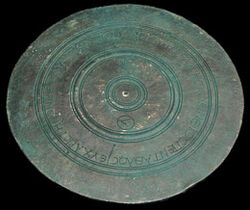| Myron of Eleutherae's Bronze Discobolus Discus | |
|---|---|

| |
|
Origin |
Myron of Eletherae |
|
Type |
Engraved Bronze Discus |
|
Effects |
Whoever picks up the discus gains incredible athletic prowess |
|
Downsides |
Slowly turns the user into bronze in an attempt to recreate the statue that was lost |
|
Activation |
Picking it up |
|
Collected by |
|
|
Section |
|
|
Aisle |
35209-3441 |
|
Shelf |
879639-4480-276 |
|
Date of Collection |
January 21, 2013 |
| [Source] | |
Origins[]
The Discobolus Statue[]
The Diskobolus of Myron ("discus thrower" Greek Δισκοβόλος, "Diskobólos") is a famous Greek sculpture that was completed towards the end of the Severe period, circa 460-450 BC. It is known through numerous Roman copies, both full-scale ones in marble, such as the first to be recovered, the Palombara Discopolus, or smaller scaled versions in bronze. Modern critics say the pose of the discus thrower is both inefficient and unlikely by modern standards.
Myron of Eleutherae[]
Myron of Eleutherae (Ancient Greek: Μύρων) working c. 480-440 BC, was an Athenian sculptor from the mid-5th century BC. He worked almost exclusively in bronze, and though he made some statues of gods and heroes, his fame rested principally upon his representations of athletes.
Effects[]
The discus absorbed the athletic energy from the statue. Pros: Whoever picks up the discus gains incredible athletic prowess. Cons: Slowly turns the user into bronze in an attempt to recreate the statue that was lost.
